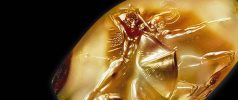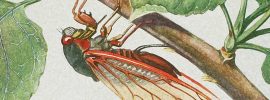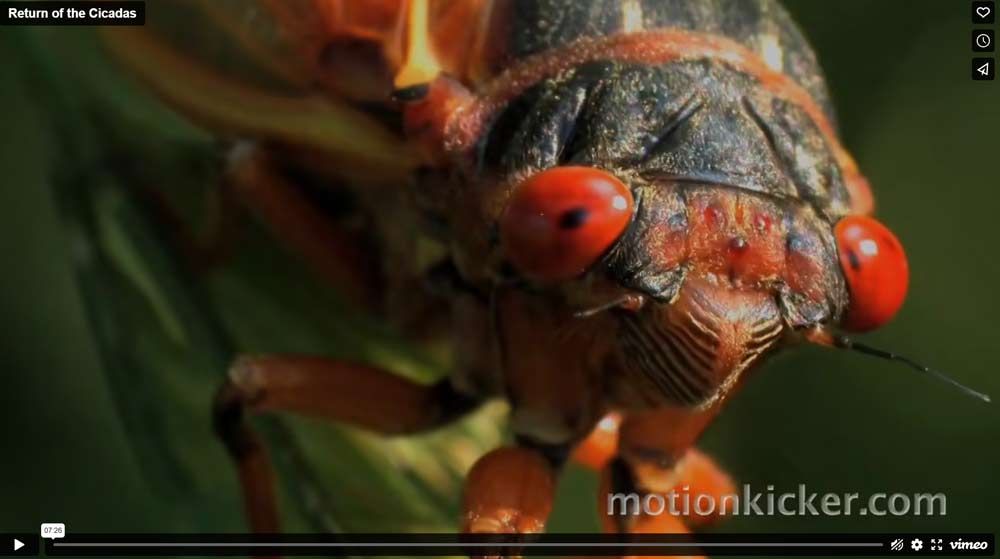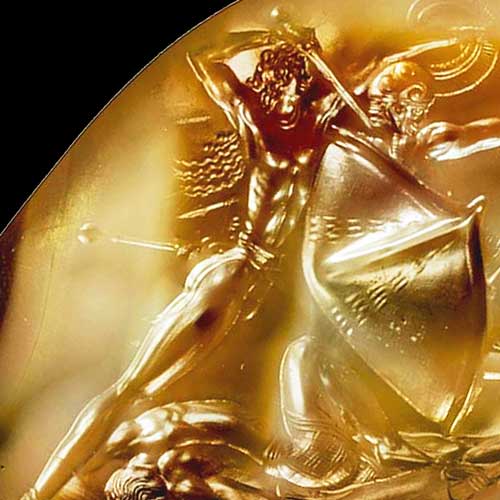
N 40°06'24.5"
E 22°29'41.1"
It was in the middle of hot summer, the peak of the holiday season. I stood in front of the Archaeological Museum of Heraklion in Crete, among the crowd of tourists. I was delighted by amazing sun of July, the lush nature on the square around and the aesthetic madness of the interior of King Minos’s palace that was about to follow soon. It was my first time in Greece, everything was new, interesting and exciting. Only this loud sawing, as if some metal against metal, did not match with the sublimity of the moment.
Seal Of Pylos
Forgotten Masterpiece

READ MORE
cicadas everywhere
masterpiece of wings
And the cicadas do not cease to fascinate me. They spend many years in the larval stage underground, buried at a depth of 30 to 250 cm. At the end of May, they come to the surface as a nymphs, shed their skins, which can hang on the tree for a long time and start to sing. Adults live only a few weeks, feeding mainly on plant juices. They have transparent, veined wings, but they fly quite awkwardly. However, these wings are real masterpieces of biotechnology. Their surface is super hydrophobic, that is, built of very small conical elements, “repelling” the water that flows down the wings. Dew condenses on their surface, so the cicadas wash their movement apparatus even if there is no rain.
But that’s not all: the conical nano-spikes from which the wings are made of, also have the property, that the bacteria that settle on them are mechanically torn to shreds. Cicada wings are the only biomaterial known to us, that destroys bacteria! Is it any wonder then, that in ancient times the cicada was a symbol of reviving life, eternal youth and immortality?

Phaistos Disk

READ MORE
madness of singing
Above all, however, cicada is made of singing. Ok, maybe this music is nice mostly for the ear of a female of the partner who makes these sounds, but it is certainly difficult to refuse him perseverance and the power of sound. I won’t undertake to describe the details of the construction of the cicada musical instrument. I’ll just say – it’s complicated. To this, the cicada approaches the phrase as a whole. Has an apparatus for producing sounds, then a kind of resonance box to strengthen it (half of the male’s body is a resonance box), finally uses the surfaces on which he sits and the relative positioning of his body, for modulation and additional melody enhancement. Like any real musician, the cicada can also listen; has a special apparatus for receiving sounds (both male and his partner), however the male turns it off when he plays. And it’s hardly surprising as the sound level he can produce reaches 120 dB, which would effectively destroy not only his own hearing aid, but also the adult man hearing organ, if he wanted to listen to a concert at a very short distance.

Plato on cicadas
I feel a certain spiritual kinship with the cicada. First of all, love of music; but also a penchant for high temperatures. The value from which my noisy artist starts to feel good is 29º C. Then also his instrument is the most effective and the music sounds really powerful. This is why cicadas can be heard best on hot days, in the afternoon, hot hours. Not only that, for better efficiency, cicadas can raise their body temperature by 4-5º C, and some species by up to 20º C above environment temperature, which in heat-variable animals is a real feat!
Cicada is made of singing and was born from singing. The ancient Greeks knew at least two myths about the origin of the cicadas. The first cites Plato in Phaedrus – one of his most beautiful and mysterious dialogues. In Benjamin Jowett’s translation [see full dialogue], the fragment reads as follows (note that Jowett calls the cicada a grasshopper, what itself calls out to heaven for vengeance, but let’s draw a veil of silence at this point):
grasshoppers [...] are said to have been human beings in an age before the Muses. And when the Muses came and song appeared they were ravished with delight; and singing always, never thought of eating and drinking, until at last in their forgetfulness they died.
So we have madness of singing to the grave. And this is human madness, only secondarily transferred to the animal kingdom. As Muses, moved by such devotion for their invention, turned avid singers into cicadas so that they could indulge in their passion without interruption. And indeed, there is something amazing about the way cicadas exist. First, many years underground in total darkness. Then, an amazing, magical transformation (see the video below), a body built like a musical instrument and four weeks of almost continuous singing in the blinding midday sun – the cicadas play several hours a day, eating almost nothing!
But what exactly is all this for? It is quite obvious to note that the cicada singing is in essence, an extreme ecstatic hymn of love. The male is after all playing a flirtatious song. Here we come to the second myth about the origin of insect-musicians.

Homeric hymn on cicadas
In the Homeric Hymn to Aphrodite from the 6th century BC we find the story of a young man named Tithonus, who was a rapsod (singer, poet) and lover of Eos – the goddess of dawn. In thanks for his love, the goddess offered him immortality. However, nothing is perfect (especially in the world of Homeric myths). Tithonus was immortal, but he was not forever young. He was getting older, he was shrinking, he was getting smaller and smaller, and finally Eos turned him into a cicada, so that she could at least hear the voice of her beloved. So love as a salvation? Or rather salvation as proof of love in spite of everything. It must be remembered that love between god and mortal was something rare and dangerous in the Homeric world, because it broke the natural, always established order of things. In the triad, the gods-humans-animals the cicadas had a unique position, being in fact each of these entities in part.
Finally, a linguistic remark. In many languages, the word cicada is a classic sonic name trying to convey the characteristic song of a tireless insect. We have cicada in English, zikade in German, cigale in French and tzitzika in Greek [Τζίτζικα]. In the ancient Greek language of Homer, however, the cicada is tettix [τέττιξ]. So, did the ancient Greeks hear a little differently? Or maybe it was the divine insects that changed the way of playing?
In Litochoro, the cicadas have a special liking for the path from Lakkos to Lambada, along the Enipeas stream. On summer days the whole valley is filling with their singing, I am grateful to them that they are not like their American cousins – who appear once in 17 years – and at the beginning of June they will come out of the ground, spread their wings, dry them in the sun and start playing. I can not wait…
Lost in Translation
Where are cicadas?

One might say that cicadas do not appear in Phaedrus at all. The ancient Greek “tettix” Benjamin Jowett translates as “grasshopper”, probably not understanding their role in dialogue and in Greek culture. Unfortunately, translators of other languages make a similar mistake. The most popular Polish translation by Władysław Witwicki uses the term “grasshopper” or “crickets”.
Appendix
cicadas and a metaphor of love
However, it seems that the cicadas are also present in Phaedrus at a much deeper level, as if at the root of Plato’s imagination, at the level of depicting the most important metaphors. Phaedrus is a dialogue about love and the soul. In this order, because for Plato the highest level of love is spiritual love. At the same time, the soul, which thanks to feeling ascends to a higher level, is winged. Soul wings play an important role in many dialogues, but they are particularly important in Phaedrus. And these wings are always described as cicadas wings! But even more than that. The basic transformation of the soul under the influence of love is describe as the transformation of the cicada from the larva to the adult form. With many details, showing careful observation and knowledge of things that astonishes even modern entomologists. Socrates describes to Phaedrus what happens to the soul and it looks like he describes the details of the emergence of the cicada from the old shell to the form of a music virtuoso. With key moments: heart palpitations, fluid secretion (one entomologists state that “the whole [cicadas] body temporarily becomes a large secreting gland”), cracking the outer shell, developing wings, and even drying them in the sun. You can read the 31 or 36 chapter of Phaedrus, or you can look at the beautiful video above. The similarity of contemporary film frames and Plato’s descriptions is striking!



